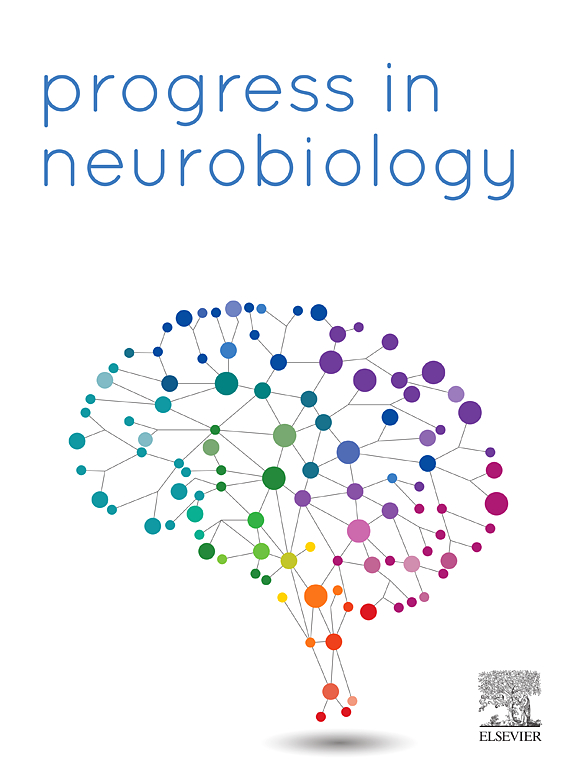NCAM2促进APP从细胞表面靶向到含有bace1的回收内体。
IF 6.1
2区 医学
Q1 NEUROSCIENCES
引用次数: 0
摘要
淀粉样蛋白前体蛋白(APP)和β位点APP切割酶1 (BACE1)在核内体中的聚合启动了在阿尔茨海默病患者大脑中积累的淀粉样蛋白-β (Aβ)肽的产生。APP和BACE1在神经元中分离,触发它们趋同的机制仍然知之甚少,这限制了减少Aβ产生的治疗尝试。神经细胞粘附分子2 (Neural cell adhesion molecule 2, NCAM2)是一种定位于细胞表面的蛋白,其增加a β水平的机制尚不清楚。我们发现APP与NCAM2的胞外结构域结合。NCAM2的胞内结构域与Rab11接头蛋白Rab11- fip5结合。NCAM2/APP复合体从细胞表面被内吞,并靶向含有bace1的rab11阳性循环内体,在那里进行加工。在转染的CHO细胞和表达NCAM2的神经元中,APP与BACE1的趋同增强。因此,在表达NCAM2的细胞中,淀粉样蛋白APP切割产物的水平增加。在缺乏ncam2的神经元中,APP在细胞表面和早期核内体中积累,并且循环核内体中的APP水平降低。Aβ低聚物和神经元活性增加了Aβ的产生,我们发现在Aβ低聚物处理的神经元或突触NMDA受体激活后,NCAM2与APP的结合增加。总之,我们的数据表明,NCAM2与APP结合,并促进APP从神经元细胞表面靶向到循环内体,APP被BACE1切割。这种调节APP和BACE1在神经元中趋同的新机制可能有助于阿尔茨海默病中Aβ的积累。本文章由计算机程序翻译,如有差异,请以英文原文为准。
NCAM2 promotes targeting of APP from the cell surface to BACE1-containing recycling endosomes
Convergence of amyloid precursor protein (APP) and β-site APP cleaving enzyme 1 (BACE1) in endosomes initiates the production of amyloid-β (Aβ) peptides that accumulate in brains of Alzheimer’s disease patients. APP and BACE1 are segregated in neurons, and mechanisms triggering their convergence have remained poorly understood, limiting therapeutic attempts to reduce Aβ production. Neural cell adhesion molecule 2 (NCAM2) is a cell surface localized protein, which increases Aβ levels via mechanisms that are not known. We show that APP binds to the extracellular domain of NCAM2. The intracellular domain of NCAM2 binds to the Rab11 adaptor protein Rab11-FIP5. The NCAM2/APP complex is endocytosed from the cell surface and targeted to BACE1-containing Rab11-positive recycling endosomes where it is processed. Convergence of APP with BACE1 is increased in transfected CHO cells and neurons expressing NCAM2. Consequently, the levels of amyloidogenic APP cleavage products are increased in cells expressing NCAM2. In NCAM2-deficient neurons, APP accumulates at the cell surface and in early endosomes, and APP levels in recycling endosomes are reduced. Aβ production is increased by Aβ oligomers and neuronal activity, and we show that the binding of NCAM2 to APP is increased in neurons treated with Aβ oligomers or after activation of synaptic NMDA receptors. Together, our data indicate that NCAM2 binds to APP and promotes APP targeting from the neuronal cell surface to recycling endosomes where APP is cleaved by BACE1. This novel mechanism regulating the convergence of APP and BACE1 in neurons can contribute to Aβ accumulation in Alzheimer’s disease.
求助全文
通过发布文献求助,成功后即可免费获取论文全文。
去求助
来源期刊

Progress in Neurobiology
医学-神经科学
CiteScore
12.80
自引率
1.50%
发文量
107
审稿时长
33 days
期刊介绍:
Progress in Neurobiology is an international journal that publishes groundbreaking original research, comprehensive review articles and opinion pieces written by leading researchers. The journal welcomes contributions from the broad field of neuroscience that apply neurophysiological, biochemical, pharmacological, molecular biological, anatomical, computational and behavioral analyses to problems of molecular, cellular, developmental, systems, and clinical neuroscience.
 求助内容:
求助内容: 应助结果提醒方式:
应助结果提醒方式:


